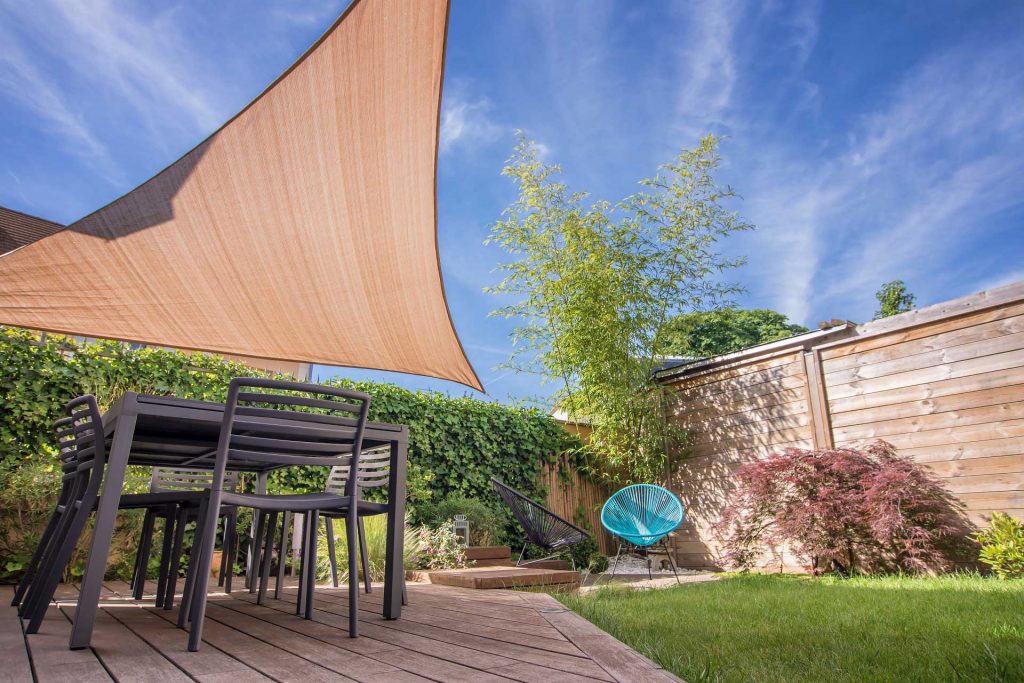A well-installed, high-quality shade sail is engineered to withstand wind gusts of at least 85 mph without compromising its integrity.
Considering shade for your outdoor space? You’re on the right path. Shade sails offer a blend of beauty, and modernity while effectively covering up outdoor spaces where you might want to block out the sun and harmful UV rays. Their flexibility and adaptable designs allow them to be sculpted to suit any situation and type of architecture.
What is a Shade Sail?

A shade sail is a tensioned structure designed and built for the outdoors. It boasts a durable fabric used in shading up areas such as a patio or deck to provide maximum shade covering protection from the sun. Shade sails are made from elastic fabric materials to allow installation by stretching the fabric and using tension to affix the corners of the shade to mounting points such as a post, tree, or wall.
How standard shade sails are made
The design of a standard porous shade sail strategically allows wind passage while preserving stability. Moreover, the installation of properly positioned waterproof variants contributes to their ability to withstand high winds, making them resilient choices for varying weather challenges.
What to consider before buying a shade sail

Avoid shade sails produced using low-quality materials as they may get damaged easily. If your shade sail was poorly stitched or the materials that were used to produce it were of low quality, it may wear and tear easier than higher-quality sails.
Blocks up to 95% of harmful UV rays and direct sunlight exposure. Protects you from the sun without trapping hot air beneath. Allows cooling breezes and light to pass through for a better airy and comfortable space.
How much does a Shade Sail Cost?
The cost of a shade sail depends on its size and how the installation is performed. You may decide to install the shade sail yourself if you are experienced in DIY; however, you will require an extra hand to accomplish this.
The cost varies based on the type of shade sail. Here’s a comparative overview:
Table (Cost Comparison)
| Shade Sail Material | Average Cost (USD) |
|---|---|
| Standard Shade Sail | $30 – $400 |
| Waterproof Shade Sail | $100 – $600 |
| Custom-Made for Winds | $500 – $1000+ |
Typically, a standard shade sail may range from $30 to $400 or higher, contingent on its size and quality. Additional expenses might include separate purchases for mounting hardware.
If you require professional installation you can expect to pay more for the services rendered. Factoring in mounting posts, concrete, labor, or any other customization that you may need, your shade sail could cost as much as $20 per square foot. According to Arizona Shade Sails, a 20 ft. x 20 ft. four-column shade (which is huge) could cost you $8,000 to $10,000 to install.
Climate Conditions vs Shade Sails
Most shade sails are fabricated to withstand a minimum of 85 mph high winds. They are designed to be installed as fully tensioned structures; the force of tension required for installing a shade sail depends on the shade size and the degree of wind exposure. Windy locations and large sails require more force to ensure they will not flap in high winds.
Understanding the weather dynamics of your intended installation area is crucial in determining how to choose the right shade sail that best suits your climate and outdoor needs.
High Winds
High winds can cause a lot of damage, especially during thunderstorms that is why it is important to buy a high-quality shade sail crafted from durable fabric. Your shade sail fabric should be strong and hard to break meaning it can take on a lot of force and pressure before it gets damaged.
If you live in an area with consistently high winds then consider custom-made shade sails. These shades can be designed to withstand high wind speeds.
Standard shade sails allow wind to pass through since they are porous; this allows the shade sails to remain sturdy during strong winds and storms. Waterproof shade sails are also able to withstand high winds if installed properly.
Rain Storms, Hail stones, and Thunder
Shade sails can become damaged during extreme weather conditions such as storms. If you live in a tropical area you may want to consider installing a waterproof shade sail. A high-quality shade may offer protection from rain storms and hail stones.
Installing
While planning to install your shade sails, make sure you think about water runoff and drainage, this is especially important when installing large shade sails. Where possible allow 1 in 5 falls for debris runoff and water drainage.
Correct installation of both the fixing points and shade sails is crucial to offer hail protection. Consult, and or use a professional installer for advice on both angles and fixing for your local weather conditions.
Pros and Cons of Shade Sails
Before you go out and purchase a shade sail, consider understanding its benefits and weaknesses.
Pros:
- Versatility: Shade sails are versatile as they offer the flexibility of being practical in almost any setting, thanks to numerous mounting options and shapes.
- Keeps the shaded area cool: Standard shade sails have a breathable fabric that allows cool air to flow through the shade, this is useful in lowering the temperature by as much as 15 to 20 degrees F beneath the shade.
- Protection against rain and UV rays. You may install a waterproof shade sail to get full protection against the rain.
- Affordable as compared to a permanent shade structure.
Cons:
- Installation is not as straightforward and may require you to hire a professional for installation.
- You will be required to mount posts to install the shade sail which may come at an additional cost.
- Shade sail may last up to 10 years; this however depends on the weather conditions in your area. If the shade is often subjected to strong winds and extreme weather it may deteriorate at a faster rate.
Where can you use a shade sail?

Applications for shade sails are many depending on one’s needs. Some of these applications include:
- Outdoor residential settings – This could be in a garden setting or over a swimming pool.
- School playgrounds and child care centers – Sail shades are good at protecting against the sun and provide UV protection.
- Outdoor lounge areas –shade sails are popularly used in the hospitality industry, where restaurants set up shade sails as a way of expanding outdoor eating areas.
- Commercial settings – Popularly used in car parks and resort settings as they are easy to maintain and look good.
Conclusion
Choosing the right shade sail and performing installation can be a hefty task. Consider hiring a professional to help you with installation to avoid disappointments.
Blocks up to 95% of harmful UV rays and direct sunlight exposure. Protects you from the sun without trapping hot air beneath. Allows cooling breezes and light to pass through for a better airy and comfortable space.

John Brown
John Brown brings a wealth of experience and passion for DIY, Home and Garden, and Woodworking. With a dedication to empowering enthusiasts, he shares insights, tips, and comprehensive guides to help you transform spaces and master woodworking skills.



